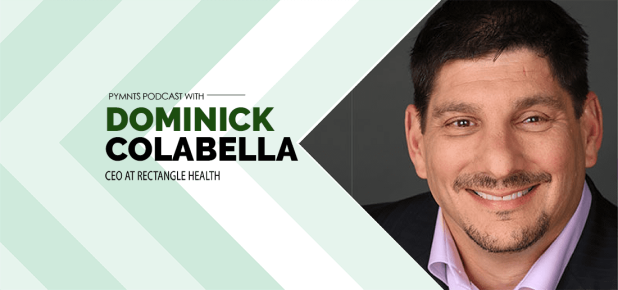Contactless Interactions Help Healthcare Providers Recoup Revenue In COVID-19 Age

Over time, technology has made it easier for healthcare providers to offer flexible payment options for patients to manage their healthcare expenses.
Most often, providers capture what’s owed right at the most common point of interaction — the front desk.
But what happens when social distancing challenges the traditional ways in which practices handle patients?
Adjusting To The COVID-19 Tipping Point
As the coronavirus spread in the United States, businesses had to pivot to a new normal — and that included healthcare practices. Practitioners grappled with reduced staff, operating hours and higher operating costs tied to personal protective equipment (PPE). Now, medical, dental and specialty offices across the country continue to provide a high level of care, albeit one that relies on safer, more socially distant engagements.
Karen Webster, CEO of PYMNTS, interviewed Dominick Colabella, CEO of Rectangle Health, a payment solution company focused on serving the entire healthcare market. Colabella said that practices were forced to readjust their operations due to the COVID-19 shutdown — adjusting their processes amid a huge challenge.
“The foregone conclusion of having your practice open and collecting payments and having people with the ability to make a payment (in person) went away… and disappeared for the first time in history,” he explained.
Leveraging Digital Tools For A Smoother Transition
Slowly but surely, patients have adopted new ways of interacting with their provider, while gradually returning to modified in-office visits. For healthcare providers, this means patients are following up on missed appointments, routine checkups, necessary care and even elective procedures they’ve put off for months.
To ensure staff and patient safety, while patient volumes rebounds, healthcare providers are finding value in the continuity of digital interactions fulfilling everything from check-in communications to uploading insurance cards, answering COVID-19 questionnaires and, of course, payments.
Looking Back To Forge Ahead
If anything, the pandemic has underscored the continuing need for healthcare payments to evolve — even though they’ve come a long way since Rectangle’s founding in the early 1990s.
History has shown us that healthcare practitioners have always had the challenge of capturing patient payments. As patient financial responsibility increased, the range of payment options remained limited. Colabella said providers had to learn to accept not just one credit card, but a variety of them. In addition, practices had to introduce payment plans.
Accepting all types of credit cards and allowing for flexible payment options has been especially important for families where large bills can run into the thousands of dollars especially across high-deductible plans. Even though healthcare payment technology continues to advance, some practices struggle to embrace those changes.
Expanding Payment Choices For Providers
As Colabella told Webster, in expanding payment choices for providers, “we realized we needed to layer on more solutions to be more meaningful — and even be multi-layer agnostic —depending on the type of practice or facility that you were going to.”
Today, the company estimates that it processes $6.5 billion annually in patient payments across 60,000 providers.
Bridging The Gap To Get Paid Faster
Earlier this year, Rectangle Health was awarded a U.S. patent for its Practice Management Bridge solution. This technology eliminates the need for manual posting of payments to practice management software.
Practice Management Bridge works alongside the provider’s existing practice management software to process payments through multiple touchpoints. Then it automatically posts those payments back to patient accounts. Rectangle Health’s proprietary solution allows practices to keep their current credit card processors or acquirers, maintaining continuity of systems.
Offering Patients Self-Service Capabilities
Consumer-facing patient payment options available through Practice Management Bridge include Apple Pay, text to pay, vaults, and recurring billing features. Because Rectangle Health’s solution fits into the existing practice management system, it can service the smallest healthcare office to the largest hospital, Colabella told Webster.
From an overall patient experience perspective, healthcare practitioners recognize the way the pandemic has changed other industries, particularly how consumers prefer to pay. Colabella pointed to the fact that restaurants have now embraced QR codes for menus because diners are using their devices to complete payments.
“That’s what we need to do for healthcare,” he said.
Anticipating Patient Needs Through Innovation
With advanced technologies, back-office processes need not leap from one disparate system to another. The exchange of information remains secure, contactless and compliant from initial patient engagement to payment. We’re in an application programming interface (API)-driven world now, he said, where layering, scaling up (or down) services and functions must be done seamlessly.
Since Practice Management Bridge is system agnostic, that means that practitioners have more “degrees of freedom” to choose how to run their operations and even decide which payment options to offer.
The most in-demand services right now, stated Colabella, include text-to-pay and patient check-in — where Rectangle Health can handle every aspect of that patient engagement from after they set the appointment to when they capture payment.
This has been especially beneficial as patients are returning to practices to resume taking care of their personal health, and patient volumes have returned to pre-pandemic levels, explained Colabella.
Leading The Way To Patient-Centricity
As providers continue to focus on delivering quality care and we get back to some sense of normalcy throughout the healthcare industry, Colabella offered, “the last thing they want to do is spend time collecting money. They really don’t know how to do it, and we simplify it for them.”
Since Rectangle Health’s inception, Colabella and his company have met the persistent challenge of capturing patient payments with innovative solutions. To overcome changing market conditions, practices must be willing to embrace change, adopt new tools, adapt to consumer demand, and be ready for a patient-centric future.
